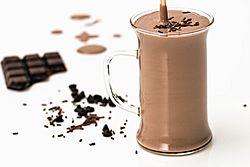Chocolate milk facts for kids

A mug of chocolate milk next to a chocolate bar
|
|
| Type | Flavoured milk |
|---|---|
| Country of origin | British Jamaica |
| Introduced | c. 17th century (by Hans Sloane) |
| Colour | Brown |
| Ingredients | Chocolate and milk; optionally sugar or substitute sweeteners and fat |
| Related products | Hot chocolate |
Chocolate milk is a yummy flavoured milk drink. It's made by mixing cocoa solids (which come from chocolate) with milk. This can be regular dairy milk or plant-based milk like oat milk. The milk helps to make the cocoa taste smooth and delicious.
Contents
How Chocolate Milk is Made
Chocolate milk can be made in a few ways. You can make it at home or buy it ready-made.
Making it at Home
To make chocolate milk at home, you mix milk with cocoa powder and something sweet, like sugar or a sugar substitute. You can also use melted chocolate or chocolate syrup. Sometimes, people add other things like vanilla for extra flavour.
When you make chocolate milk at home, the cocoa powder particles can sink to the bottom. So, it's a good idea to shake or stir your drink before you sip it!
Ready-to-Drink Chocolate Milk
Many chocolate milk drinks are sold ready to drink in cartons or bottles. These are made in factories. To stop the chocolate bits from sinking, factories often make the milk thicker. They might add special ingredients like carrageenan. This helps the chocolate stay mixed evenly in the milk.
Most ready-to-drink chocolate milk needs to be kept in the fridge. However, some types are treated with a special process called UHT. These can be stored at room temperature until you open them. But everyone agrees, chocolate milk tastes best when it's cold!
Chocolate Milk and Your Health
There's been a lot of talk about how healthy chocolate milk is, especially for kids.
Sugar Content
One main concern is the amount of sugar in chocolate milk. It often has more sugar than plain milk. Some schools have even stopped serving chocolate milk because of its high sugar content. This is because too much sugar can lead to health problems like childhood obesity.
Nutrients and Benefits
Even with the added sugar, chocolate milk still has many good nutrients from the milk itself. These include calcium for strong bones and protein. Some studies have even suggested that chocolate milk can be a good drink for athletes after a tough workout. It helps their bodies recover because it has a good mix of carbohydrates and protein. Plus, it's often cheaper than special sports recovery drinks!
You might hear that chocolate has something called oxalic acid. This can stop your body from absorbing all the calcium from the milk. But don't worry! The amount in chocolate milk is very small, so it doesn't really affect how much calcium your body gets.
History of Chocolate Milk
People have probably been mixing milk with chocolate for a very long time!
The first cows were brought to the Caribbean in 1493. And cocoa beans arrived in Europe in the 1520s.
A long time ago, in the 17th century, an Irish botanist named Hans Sloane is often given credit for inventing chocolate milk. He was in Jamaica and tried a local drink made from cocoa and water. He didn't like it much. But when he added milk, he found it tasted much better! However, some historians say that Jamaicans were already making a hot drink with cocoa, milk, and cinnamon even earlier, around 1494.
Later, in the late 1800s, a Swiss businessman named Daniel Peter found a way to make a solid, dry version of chocolate milk. This made it easier to store and transport. He eventually created milk chocolate in 1875, which is a solid form of chocolate with milk.
See also
 In Spanish: Leche chocolatada para niños
In Spanish: Leche chocolatada para niños
Images for kids


